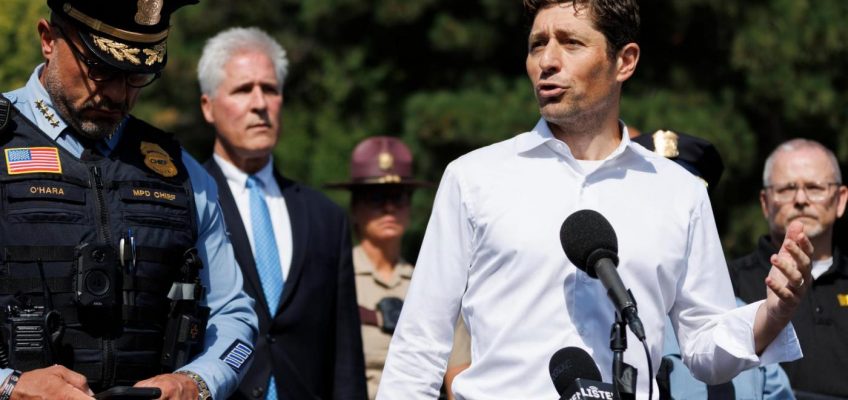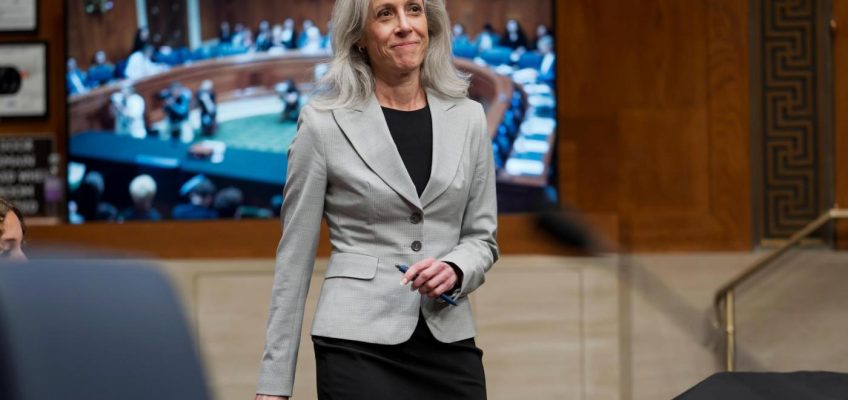As recently as a year ago, if you were being recruited to play basketball at the University of St. Thomas and you wanted to see the weight room, you might be met by a blank stare. Johnny Tauer, who has coached the Tommies men’s hoops program for more than a decade, admitted that in the past, recruits would have to ask three times before they were allowed to see the weight room, which one alumnus jokingly compared to a broom closet in size.
On Wednesday, as members of the media got their first peek inside Lee and Penny Anderson Arena, the $183 million new home for the Tommies men’s and women’s basketball programs and men’s and women’s hockey programs, Tauer practically beamed when talking about all he and his program can offer those who want to dibble, pass and shoot for St. Thomas in the future.
Members of the Twin Cities media were given a first look at Anderson Arena on the University of St. Thomas campus in St. Paul Wednesday, Aug. 27, 2025. (Jess Myers / Pioneer Press)
“We have a standard of excellence on the court, and when you look at this place, I think it’s something that’s going to be really inspiring and also a place that people want to gather,” said Tauer, as the one-hour tour concluded with remarks by four of the school’s coaches. “It’s going to be an electric atmosphere, whether it’s basketball or hockey, or the other events we hold here. It kind of gives me chills, honestly.”
The 253,000-square-foot building is still awash in bare concrete, plastic sheeting held up with masking tape and stacks of purple seats waiting to be installed, but all of that will change in less than two months. The building is slated for an official opener on Friday, Oct. 24, when the Tommies women’s and men’s hockey teams host Providence in their first-ever on-campus games.
Atmosphere matters
The Tommies have played men’s hockey off-campus for decades at the State Fairgrounds Coliseum and more recently at the 900-seat St. Thomas Ice Arena in Mendota Heights, on the campus of St. Thomas Academy prep school. The move to the new rink, located near the corner of Grand and Cretin on the south side of the university, comes after at least two other off-campus locations were considered.
St. Thomas had discussions about buying the property of the Town & County Club, a private golf course a bit north of the campus, and had discussed the construction of an athletic facility at Highland Bridge, the site of the former Ford Motors plant south of campus. When Lee and Penny Anderson offered a $75 million gift to the school to build on-campus, it became an easy decision.
Anderson Arena will seat 5,300 for men’s and women’s basketball and 4,000 for men’s and women’s hockey. As viewed on Wednesday, it was laid out as a rink, with hockey boards and plexiglass set up, but without ice installed. St. Thomas athletics director Dr. Phil Esten stressed the work that was done to make a multi-purpose facility feel hockey-specific or basketball-specific depending on which team calls it their home on any given night.
Media tour the Anderson Arena on the University of St. Thomas campus in St. Paul Wednesday, Aug. 27, 2025. (Jess Myers / Pioneer Press)
“As we designed it, I think you’ll see once we open that when it’s set up for hockey, it should feel like a hockey arena, and when it’s set up for basketball it should feel like a basketball arena,” said Esten, who opened his remarks by offering thoughts and prayers to those affected by the mass shooting in Minneapolis earlier in the day.
The tour included a look inside the locker rooms for hockey and basketball, which are state-of-the-art including players’ lounges, study areas, a full athlete nutrition area, a well-equipped sports medicine center and the weight room that Tauer is happy to show off to prospective future Tommies. The facility includes a full size practice hockey rink with seating for 700 and separate practice courts for the men’s and women’s hockey teams. The Tommies soccer and softball programs also will be housed in the building.
Neighborhood critics
Long before official plans were in the works for the arena, some members of the surrounding neighborhood were organized in opposition to what they perceive as a traffic and parking headache on dozens of nights per year. While most of their efforts to delay the project have been rebuffed, the attorney for Advocates for Responsible Development, Dan Kennedy, said that they are not done fighting.
In an email to the Pioneer Press, Kennedy noted that following the St. Paul City Council’s approval of the site plan, the group filed a lawsuit challenging that approval and they expect a ruling from judge Steven Smith of the Ramsey County District Court sometime in early October. Specifically, they note that the maximum building height allowed by the city’s zoning is 39 feet, and the arena is 75 feet tall in some places.
Building height is just one concern according to neighborhood activists. In an email to the Pioneer Press, one member of Advocates for Responsible Development, who asked not to be named, said there have already been negative consequences around the arena.
“The full impacts of the arena are yet to be felt. However, even construction has been disruptive, dirty and traffic tangling,” they wrote. “(St. Thomas) has not provided adequate on-site parking for event attendees, depending instead on neighborhood street parking to accommodate attendees. I’m sure on campus students will attend, but they will be the minority.”
There is a parking ramp with a 900-car capacity adjacent to the arena, and another parking facility on campus. Esten said the school has worked with the neighborhood in an effort to make getting to and from the arena a smooth process, and to lessen the impact on the surrounding community.
“I feel really good about the plan we have in place from a traffic management standpoint and from a parking management standpoint,” Esten said.
The first games for the four main tenants are Oct. 24 for women’s and men’s hockey versus Providence and Nov. 8 for women’s and men’s basketball versus Army.
University of St. Thomas hosts ‘upskilling’ training for machinists
St. Thomas basketball gets commitment from Cretin-Derham Hall guard Jojo Mitchell
Tommie-Johnnie rivalry renewed with Dec. 11 men’s basketball game in St. Paul
Andy Peters tries to take hold of St. Thomas starting quarterback job
College football: St. Thomas enters season with FCS playoff hopes




